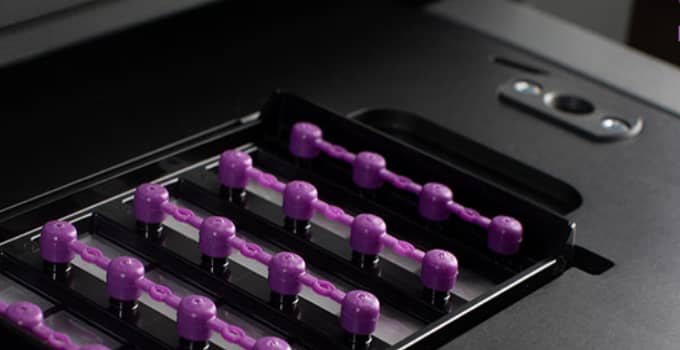A PCR machine or thermal cycler is a laboratory equipment used for amplifying small segments of DNA. It plays an integral role in wide-ranging applications, including cloning, library generations, mutagenesis, expression profiling, and more.
Thanks to the advances in technology, PCR has revolutionized the detection of RNA and DNA and evolved from conventional to digital. Digital PCR systems offer a novel approach to PCR, enabling more precise detection and quantification of nucleic acids.
What Exactly Is PCR?
PCR is a shorthand for a polymerase chain reaction, a molecular biology process that allows for rapid production of specific DNA sequences.
As with other laboratory procedures, polymerase chain reaction involves a series of steps and various components. The standard components required for PCR include:
- a DNA sample
- specific DNA primers
- four kinds of DNA nucleotides
- DNA polymerase
- a conventional or digital PCR machine
The PCR process begins with denaturation. In this first step, the two strands in the DNA double helix are separated. The separation happens by denaturing or raising the mixture’s temperature to break the hydrogen bonds between the complementary DNA strands.
Next to denaturation is annealing. The temperature is approximately 5 °C below the melting temperature of the primers (often 45–60 °C) to bind primers to the target DNA sequences and initiate polymerization.
The last step is extension or elongation. Here, the reaction is rapidly heated to 72 °C, which is the optimal temperature for DNA polymerase activity. This process enables the DNA polymerase to elongate or extend the PCR primer accurately, making a copy of the target DNA.
Weighing the Differences of Digital PCR & Traditional PCR
While traditional PCR and digital PCR (dPCR) both visualize specific DNA sequences, these two techniques differ in many ways. The former is semi-quantitative, while the latter allows absolute quantification of nucleic acids.
Traditional PCR
Traditional PCR methods or machines use Agarose gels for the detection of PCR amplification at the final phase of the PCR reaction. Agarose gel electrophoresis is a basic technique in molecular biology, which is commonly used for the analysis of PCR products, plasmid DNA, and products of restriction enzyme digestion.
It may take time to obtain the Agarose gel results because of the end-point detection. The results are not automated and based only on size discrimination, which may not be very precise.
Below are a few of the drawbacks of end-point detection:
- poor accuracy
- low sensitivity
- low resolution
- non – automated
- post PCR processing
- short dynamic range < 2 logs
- size-based discrimination only
As discussed, conventional PCR produces semi-quantitative results. The results are not expressed in numbers and visualized using an intercalating dye such as ethidium bromide or Sybr Safe.
Additionally, the concentration of nucleic acids is determined by comparing the amplified band intensity on an electrophoresis gel to a known standard.
Since it involves amplification of DNA, this PCR technique is limited to sequencing, genotyping, and cloning.
What only sets traditional PCR is that the machine used in this method is relatively cheaper than a digital PCR machine. Clinical facilities typically house a conventional thermal cycler to use for genetic testing or diagnosing diseases.
Digital PCR
As the name suggests, digital PCR amplifies nucleic acids in a digital format. It also directly quantifies and facilitates the measurement of the actual number of molecules or the target DNA.
This technique follows the concept of limiting dilutions. The sample is diluted and split into several thousands of sub-reactions to classify individual target copies as either positive (containing target) or negative (no target present).
Because the fraction of positive and negative reactions is measured, digital PCR can determine the absolute quantification of the target concentration. The precise measurement it creates makes dPCR ideal for applications requiring the detection of tiny quantities of nucleic acid sample including:
- single-cell analysis
- rare sequence detection
- rare gene expression analysis
- copy number variation analysis
For these reasons, a digital PCR machine suits the needs of clinical laboratories. This type of thermal cycler provides a precise measure of DNA molecules, better detection of low-copy-number variants, and is less affected by poor amplification efficiency and sample inhibitors.
However, dPCR also has its limitations. Digital PCR systems have lower throughput. They generally accommodate a smaller input sample volume per reaction than most common qPCR platforms do.
Summary of Key Differences between Traditional & Digital PCR
|
Traditional PCR |
Digital PCR |
|
|
|
|
|
|
|
|
|
|
|
|
The Takeaway
Traditional PCR is limiting because it measures the plateau phase or end-point of PCR reaction. Digital PCR, on the other hand, partitions a sample into many individual real-time PCR reactions, generating an absolute answer for the exact number of target molecules in the sample.
These key differences of the two PCR techniques are also crucial buying factors to know whether a clinical or research laboratory needs a traditional or a digital PCR machine.



